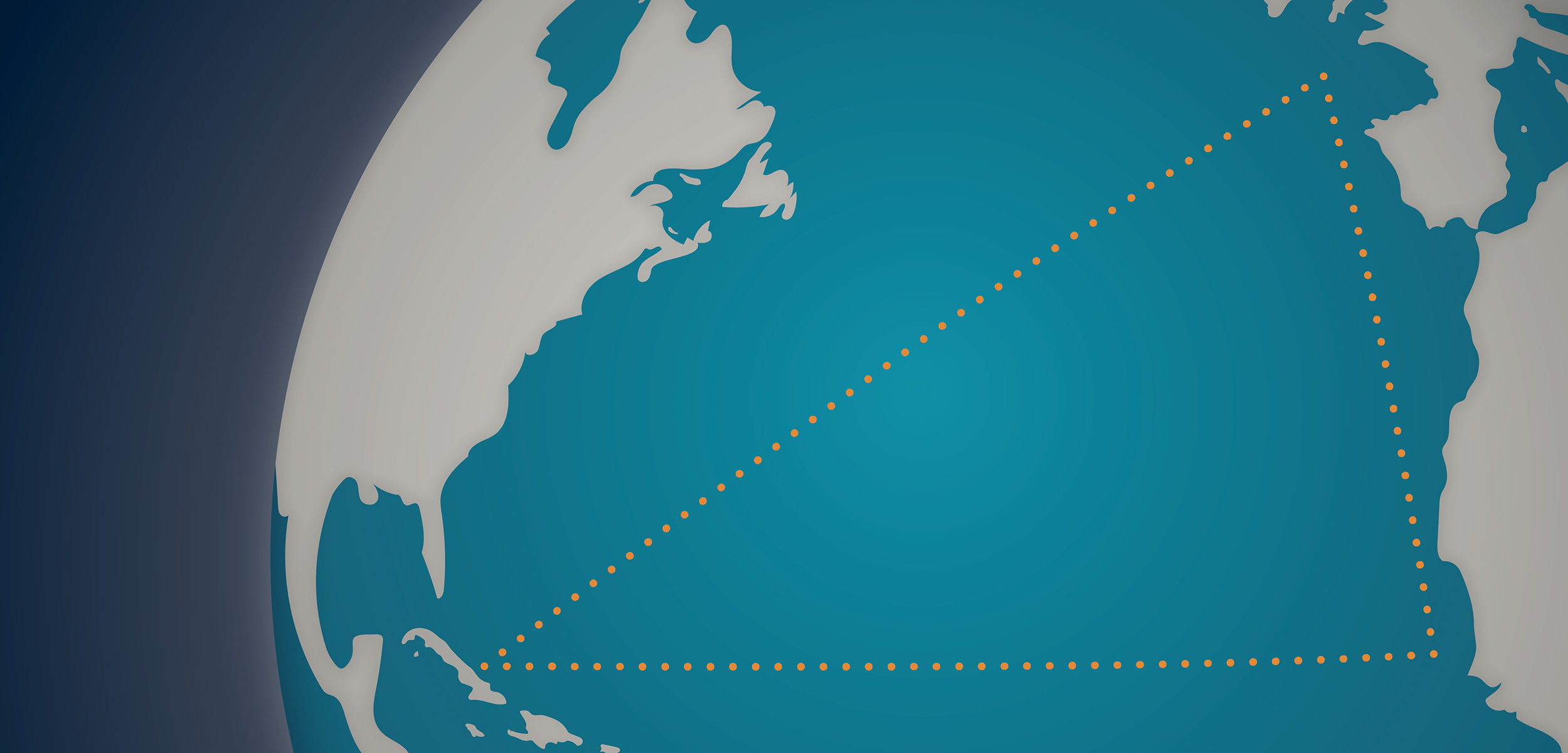All Three Sides of the Story
Five geographical triangles that shaped the ocean’s history.
Article body copy
Give humans chaos, and we’ll find a pattern. It’s one of the things we do best. There’s even a fancy neuroscience word for when we impose order on what we see: apophenia, or “appears apart from.” This phenomenon makes us see a pattern in random points on a map, or a face in a cluster of shapes. (Or, perhaps, the Virgin Mary in toast.) Oceans teem with chaos—from unprovoked shark attacks to mysteriously disappearing vessels to fantastically convoluted coral-reef ecosystems—that can trigger this pattern recognition. One shape that emerges as we grapple with such phenomena is the triangle. Maybe that’s to be expected, since triangles are commonplace, appearing in everything from alchemical formulas to corporate logos where they represent strength, law, and stability. Or maybe we just like keeping our chaos within clearly ordered boundaries. Either way, here are all three sides of the story behind five geographical ocean triangles.
Bermuda Triangle
The Bermuda Triangle, a swath of the Atlantic Ocean bounded by Miami, Puerto Rico, and Bermuda, has allegedly caused the disappearance of at least a dozen ships and planes. A 1950 Miami Herald article first collated the region’s unexplained losses, which included a plane with 25 passengers in 1948 and five navy torpedo planes in 1945, spurring tales of its “supernatural” attributes. Though rational explanations abound—the powerful Gulf Stream sluices through the triangle, possibly whisking away evidence of wrecks, and seasonal hurricanes batter the coast—the mystery of this scalene enigma persists.
Dragon’s Triangle
At least five vessels have met their demise in the sinister Dragon’s Triangle off the southern coast of Japan, including a research boat that was engulfed in the eruption of an undersea volcano. Some unexplained-phenomena buffs have taken this pattern seeking one step further and claim that the Bermuda and Dragon’s Triangles are two of twelve “vile vortices”—energetic epicenters staggered geometrically around the world that also include sites such as Easter Island and the area where Malaysia Airlines Flight 370 likely vanished.
Red Triangle
Of California’s 114 unprovoked shark attacks on record since 1926, about a third have taken place within California’s Red Triangle, which stretches from Monterey Bay north to Bodega Bay near San Francisco and out past the Farallon Islands. Why? Because no predator can resist a buffet. The food-rich waters off the California coast lure marine mammals, including elephant seals, sea lions, and sea otters. This in turn attracts lots of great white sharks, and the Red Triangle is one attack hotspot. Such epicenters tend to correlate with denser human populations—in this case, the San Francisco area— especially in a state where water sports are popular. But, even in the triangle, attacks are relatively rare. You’re more likely to die falling out of bed.
Atlantic Trading Triangle
Human action triggers some marine chaos. The Atlantic Trading Triangle was first drawn by prevailing winds, but beginning in the 1500s, humans filled it in with a bewilderingly brutal economy. This triangle linked Europe, Africa, and the Caribbean. Instead of fighting west winds across the Atlantic, European ships sailed south, to below 30 degrees latitude, where easterly trade winds blow off the coast of Africa. These carried the ships to the Caribbean, where they could catch the prevailing westerlies back to Europe. While this route sustained the transatlantic economy for centuries, it also enabled the slave trade. Boats delivered slaves from Africa to Caribbean plantations. After their human cargo disembarked, traders took on raw goods, such as sugar, and delivered these to Europe, where they were transformed into goods, such as rum, that were then traded back to Africa.
Coral Triangle
Dubbed the “Amazon of the Seas,” the staggeringly biodiverse Coral Triangle between the Philippines, Indonesia, and the Solomon Islands hosts 76 percent of the world’s coral species and thousands of reef-fish species. Unfortunately, development and overfishing are serious threats, and climate change is already bleaching the coral. Why should we care about a reef’s biodiversity? One reason is resilience: the more species that live on the reef, the greater the chance that the ecosystem will survive disruptions such as climate change or pollution. Defining the region by encapsulating all this complexity under the tidy moniker “Coral Triangle” is an important step for building awareness.

